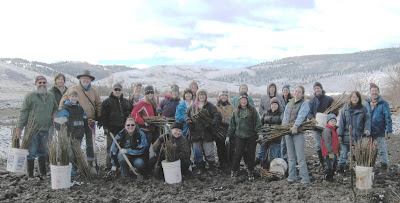The Wallowa County Chieftain’s sensationalist headline screamed “Wolves at the Door: Wallowa County Ranchers Face Their Worst Fears.” This wolf activity and the preceding comments by some of the ranchers at the events gave me plenty to think about this week.

There were clearly a few over-the-top statements by some ranchers at the films. One claimed to be able to control all the threats to his livestock except for wolves. Yet he never did explain how he controlled the weather. This same rancher artificially inflated the number of livestock he had lost to wolves in order to make the threat sound much worse than it was, but in doing so he made a huge error: he admitted that he didn’t ear-tag all his calves and didn’t know for sure how many he sent out to pasture. His single-minded message was that he “needs the tools to control wolves,” which, in case it isn’t obvious, is just a euphemism for wanting to shoot wolves.
Another rancher said that he had no room to work with anyone on this issue, and that the only solution for him is that there are no wolves, period. His livestock allotment is on federal public land, in the heart of the Imnaha pack’s territory.
My initial thought after hearing the ranchers speak at the Lords of Nature showings was that I’ve never heard such a bunch of whiners. I thought ranchers prided themselves on their stoic, steady ability to deal with everything that gets thrown their way. I also thought they believed in fully functioning landscapes. The comments I heard came across more like a bunch of kids throwing a tantrum. I thought they sounded like the classic “bury the head in the sand” approach, refusing to admit change is happening even when it clearly is. I know these few vocal ranchers don’t necessarily speak for other ranchers who are indifferent about wolves or may even like wolves as long as wolves don’t kill livestock. But that reaction of mine to their comments isn’t very helpful either, and so I made myself move on to more constructive thoughts, namely, where do we go from here?
Step one, I think, is to admit as a community that change is happening. Wolves are here and they’re not going away. This is, after all, historic wolf country, and I’ve heard lots of people point out that the ranchers are the interlopers, not the wolves. There is also the growing recognition that our wildlands are not fully functioning without top predators like wolves.
But the fact remains that ranchers are operating in wolf country, so what do we do about that? Well, we have learned that the visit to the ranch by the Imnaha pack was not entirely random or unexpected. They were known to be in the area for at least a few days prior to the visit, and they dug up a recently buried cow carcass near the ranch.
We have better tools to deal with situations like this than we are currently applying. If wolves are in the area, we can set up fladry and other means of scaring wolves off … in advance of any wolf activity. We can practice better carcass disposal, or work together to devise a better system of dealing with carcasses. Ranchers operating in wolf country will have to avoid sloppy practices, and must know how many of their livestock are where. And not only ranchers, but wolf advocates can step up to deal with these situations (as some already do).
In my mind there is also a huge distinction between ranching operations on private land and those on public land. The Oregon Wolf Plan recognizes those distinctions, and ranchers must come to terms with that. After all, on national forests there is a legal mandate for maintaining viable wildlife populations. There is no legal mandate to allow ranching.
The primary point is that we need to be able to have conversations about these issues, away from the over-the-top rhetoric. I’m not confident, however, that we’ll get there. Anti-wolf rhetoric seems to be on the upswing. I suspect we’ll battle this out in the Oregon legislature, as we have for the last several sessions. The outspoken wolf opponents – and some of our politicians – want to make this into rural/urban issue, but it isn’t. There are wolf advocates throughout this state.
HCPC is a rural-based group, and we advocate for the return of wolves—and will continue to do so. Yet we also believe that there are solutions that can only come about with a joint commitment to solving these wolf-related issues. We challenge the ranching community to make the same commitment.



